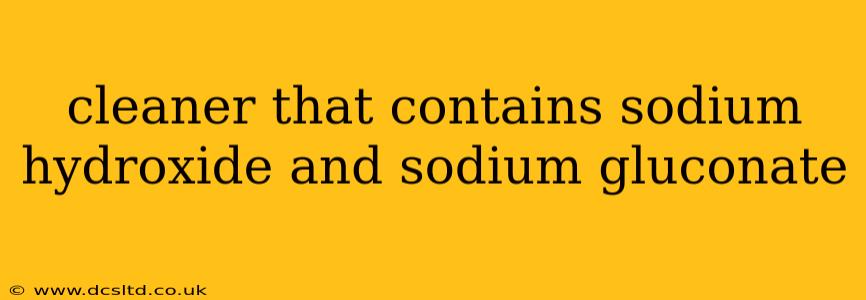Many cleaning products utilize a combination of chemicals to achieve effective cleaning. Two common ingredients found together in certain cleaners are sodium hydroxide (NaOH), also known as lye or caustic soda, and sodium gluconate. Understanding their individual roles and synergistic effects is crucial to safe and effective use.
What is Sodium Hydroxide (NaOH)?
Sodium hydroxide is a highly alkaline chemical known for its powerful cleaning properties. It's a strong base that readily reacts with grease, oils, and other organic matter, breaking them down effectively. This makes it a key component in many drain cleaners, oven cleaners, and other heavy-duty cleaning solutions. However, its strong alkalinity means it's corrosive and requires careful handling. Always follow the manufacturer's instructions precisely and wear appropriate protective gear, such as gloves and eye protection.
What is Sodium Gluconate?
Sodium gluconate serves a different purpose in cleaning solutions. It acts as a chelating agent, meaning it binds to metal ions, preventing them from interfering with the cleaning process. Hard water contains minerals like calcium and magnesium, which can react with other cleaning agents and reduce their effectiveness. Sodium gluconate helps to prevent this by sequestering these metal ions, allowing the other cleaning components, like sodium hydroxide, to work more efficiently. It also offers some mild cleaning properties itself and contributes to the overall cleaning solution's stability.
Why are Sodium Hydroxide and Sodium Gluconate Used Together?
The combination of sodium hydroxide and sodium gluconate creates a synergistic effect, enhancing the overall cleaning power of the product. Sodium hydroxide provides the powerful cleaning action, while sodium gluconate ensures this action is not hindered by hard water minerals. This results in a cleaner that is:
- More effective: The chelating action of sodium gluconate improves the performance of the sodium hydroxide.
- Less inhibited by hard water: The cleaner maintains its effectiveness even in areas with hard water.
- Potentially more stable: Sodium gluconate can help stabilize the overall formulation, preventing precipitation or degradation.
What types of cleaners contain these ingredients?
You'll commonly find this combination in:
- Heavy-duty drain cleaners: To break down clogs effectively and prevent mineral buildup.
- Industrial cleaning solutions: For degreasing and cleaning in various industrial settings.
- Certain oven cleaners: To efficiently remove baked-on grease and grime.
It's important to note that the exact formulation varies significantly between different cleaning products. Always read the product label carefully before use and follow the manufacturer's instructions.
Is this combination safe?
While sodium gluconate is generally considered safe, sodium hydroxide is corrosive. The combination's safety depends entirely on the concentration of sodium hydroxide and the proper use of the product. Always follow the product's safety guidelines meticulously. Never mix different cleaning products, as this can lead to dangerous chemical reactions. If you get any of the cleaner on your skin or eyes, immediately flush with plenty of water and seek medical attention if necessary.
What are the potential risks associated with using cleaners containing sodium hydroxide and sodium gluconate?
The primary risk comes from the corrosive nature of sodium hydroxide. Direct contact can cause skin burns, eye damage, and respiratory irritation. Always wear appropriate protective gear, including gloves and eye protection, when using cleaners containing sodium hydroxide. Adequate ventilation is also crucial to minimize the risk of respiratory problems.
How should I dispose of cleaners containing sodium hydroxide and sodium gluconate?
Always refer to the product label for specific disposal instructions. Generally, these cleaners should be disposed of according to local regulations. Never pour them down the drain unless explicitly stated on the label. It’s best to contact your local waste management authority for guidance on the proper disposal method for your area.
This information is for educational purposes only and does not constitute professional cleaning or safety advice. Always refer to the product label and safety data sheet (SDS) for detailed information and safety precautions.
